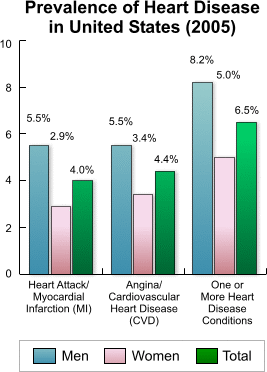Data & Statistics
Other Features
Featured Data & Statistics

Prevalence of Heart Disease — United States (2005)
Heart disease has been the leading cause of death in the United States for the past 80 years and is a major cause of disability. Respondents to the 2005 Behavioral Risk Factor Surveillance System (BRFSS) survey* answered questions about whether a doctor or other health professional had ever told them that they had experienced a "heart attack, also called a myocardial infarction (MI)" or "angina or coronary heart disease (CHD)." Differences in prevalence, or the number of cases in a given population during a set timeframe, were assessed by age, race/ethnicity, sex, education, and state or territory of residence. Data were weighted to reflect each state and territory's population aged ≥18 years, and results were age adjusted to the 2000 U.S. adult standard population. Race/ethnicity identification was provided by respondents; persons who identified themselves as multiracial were included in a separate category.
In 2005, a total of 4.0% of respondents reported a history of MI, and 4.4% reported a history of angina/CHD. A total of 6.5% of respondents reported a history of one or more of these conditions (MI, angina/CHD, or both). Men had a significantly higher prevalence of MI history than women 5.5% versus 2.9%, angina/CHD 5.5% versus 3.4% and one or more of these conditions 8.2%versus 5.0%. The prevalences of history of MI, angina/CHD, and one or more of these conditions increased among successive age groups and decreased with higher education.
For more information, see:
- Heart Disease Prevention: What Can You Do?
- Heart Disease Facts and Statistics
- About Heart Disease
- Women and Heart Disease Fact Sheet
- Men and Heart Disease Fact Sheet
1Greenlund KJ, Giles WH, Keenan NL, et al. Heart disease and stroke mortality in the 20th century. In: Ward J, Warren C, eds. Silent victories: the history and practice of public health in twentieth century America. Oxford, England: Oxford University Press; 2006.
*BRFSS is a state-based, random-digit—dialed telephone survey of the noninstitutionalized U.S. civilian population aged ≥18 years living in households and is administered by state health departments in collaboration with CDC. 2005 respondents lived in all 50 states, the District of Columbia (DC), Puerto Rico and the United States Virgin Islands (USVI). Additional information regarding BRFSS data and methods is available at http://www.cdc.gov/brfss/technical_infodata/surveydata/2005.htm
Page last updated: August 8, 2007
Content source: National Center for Chronic Disease Prevention and Health Promotion
Content owner: National Center for Health Marketing
